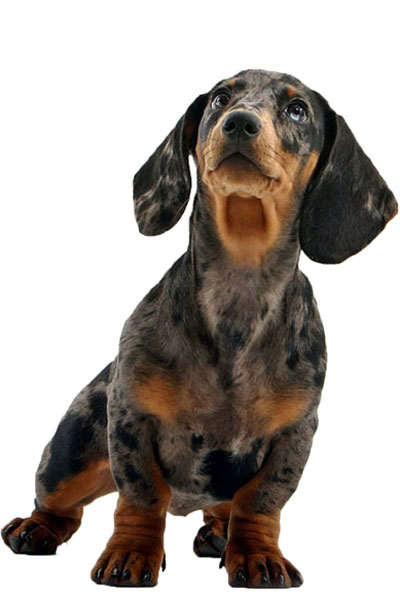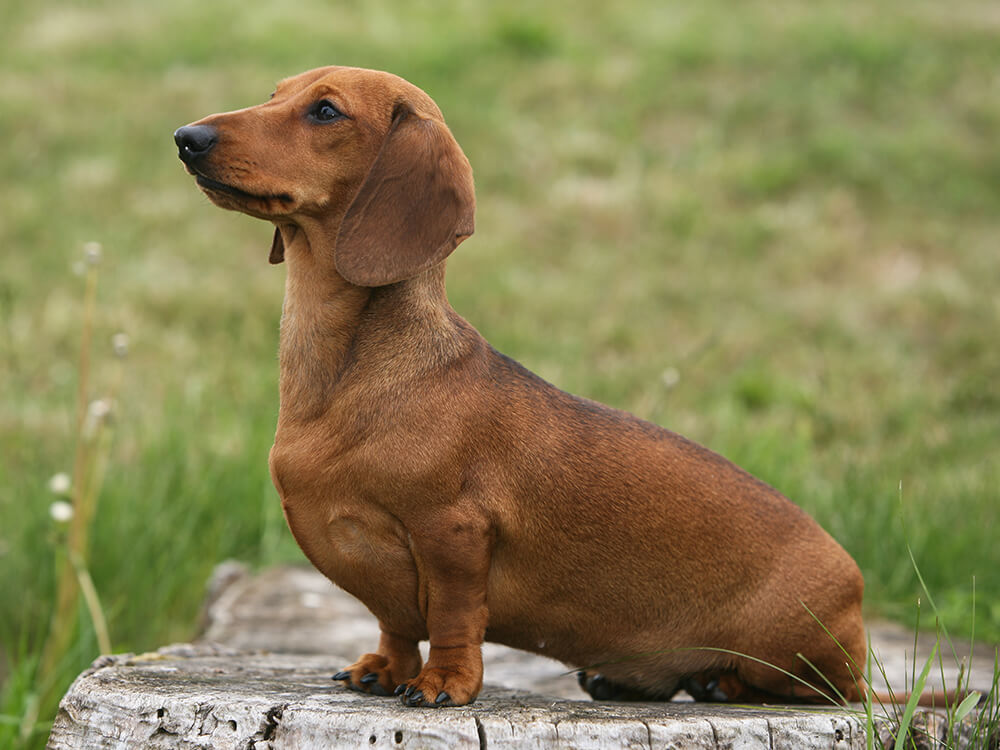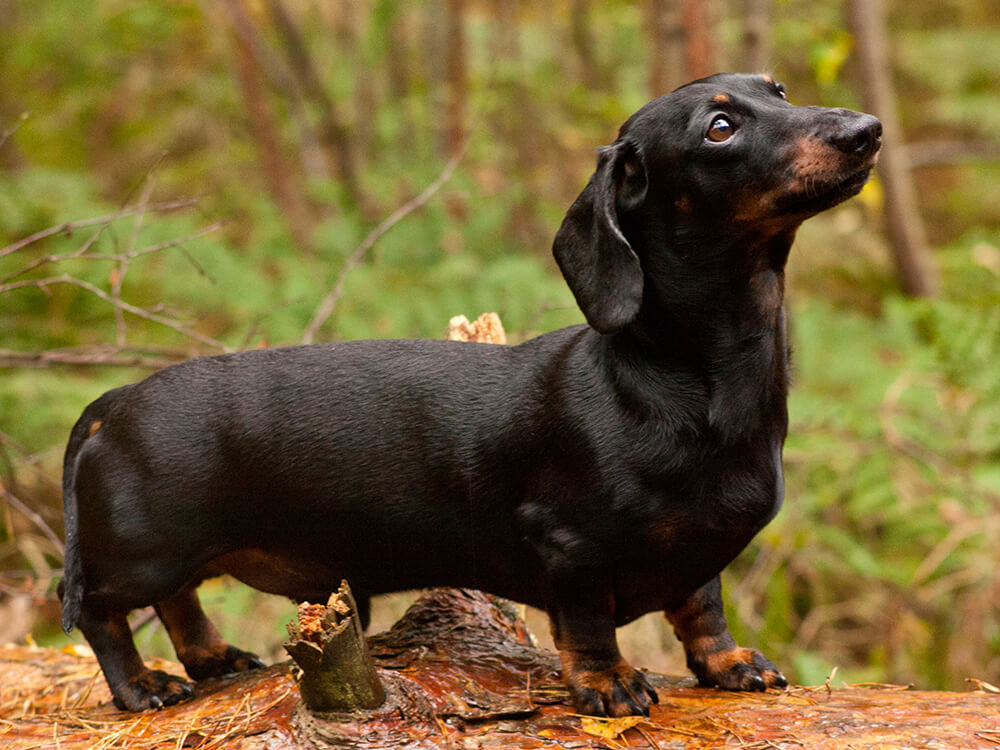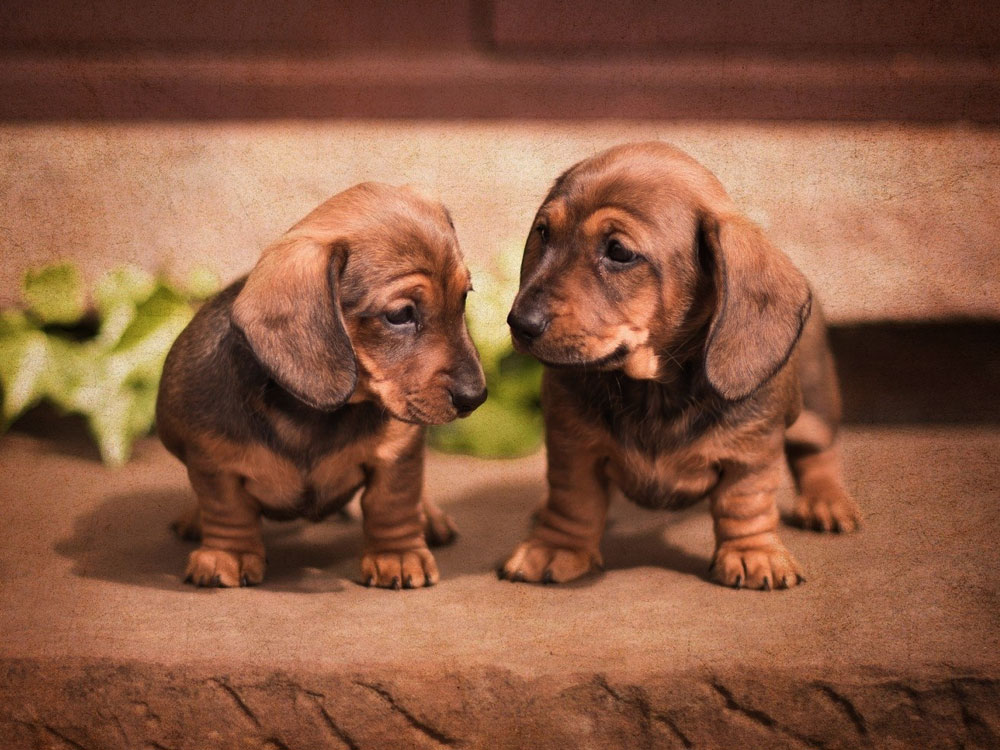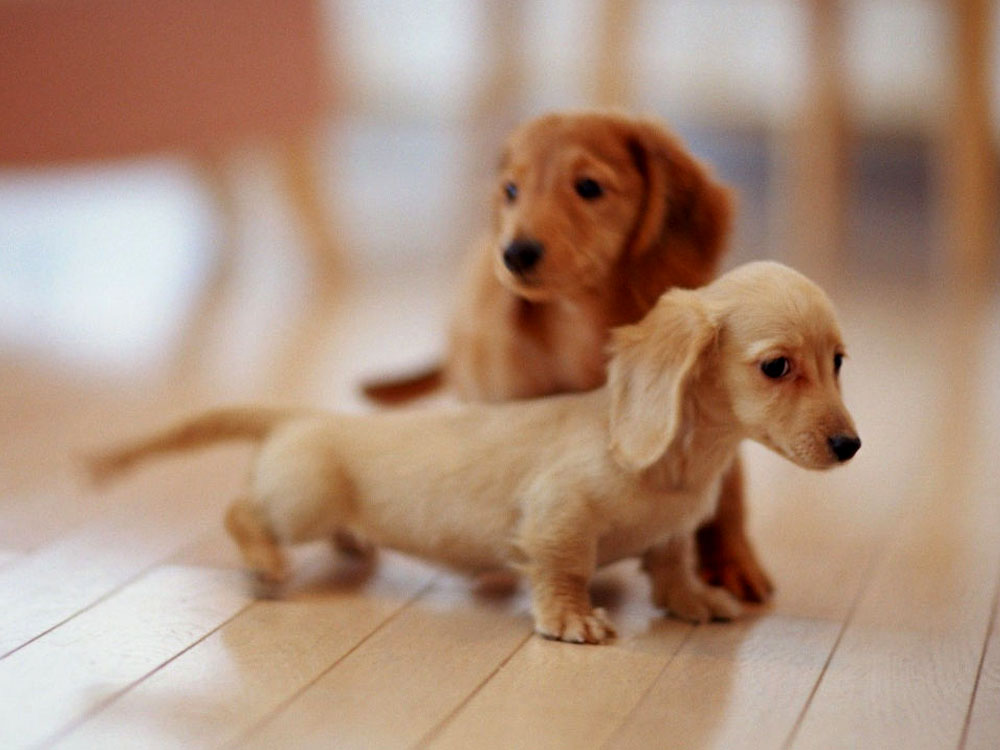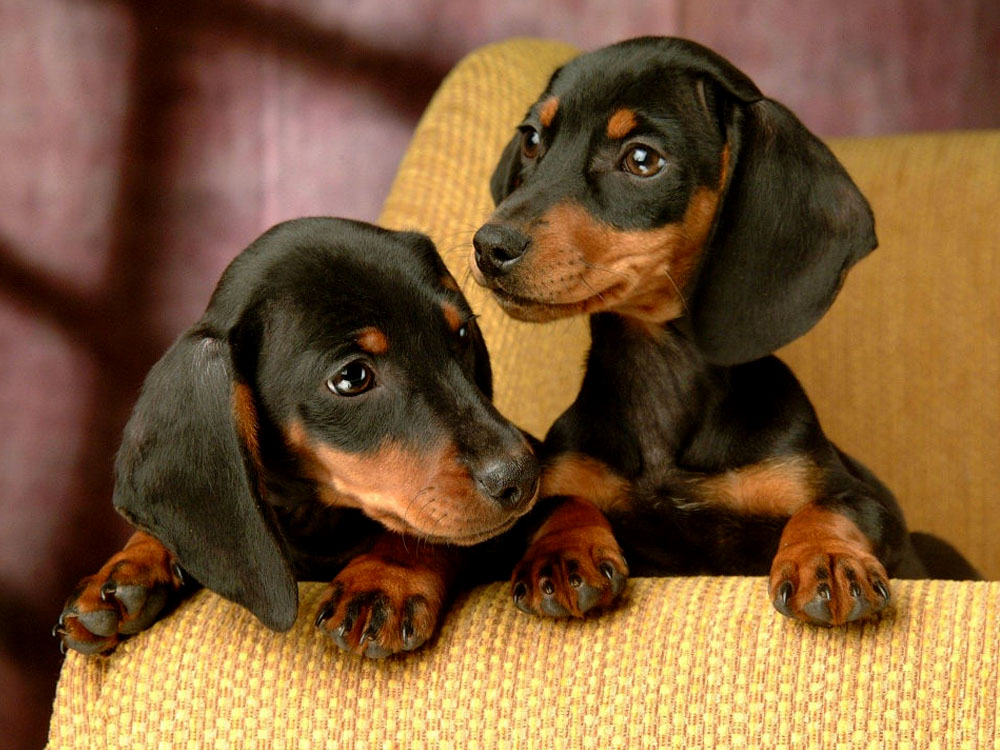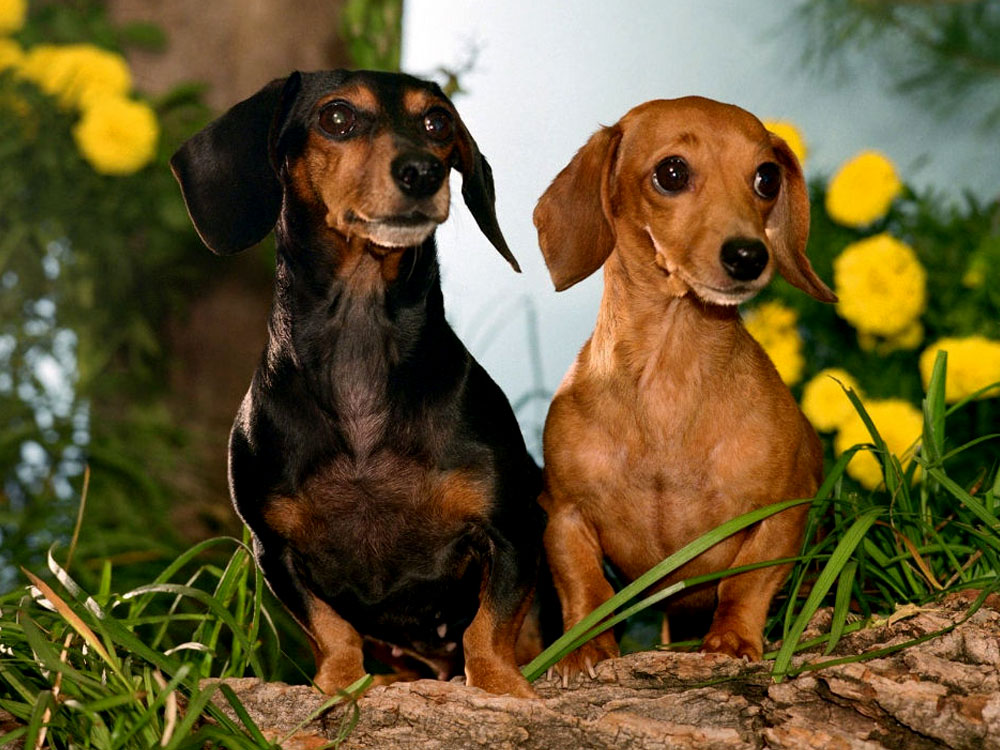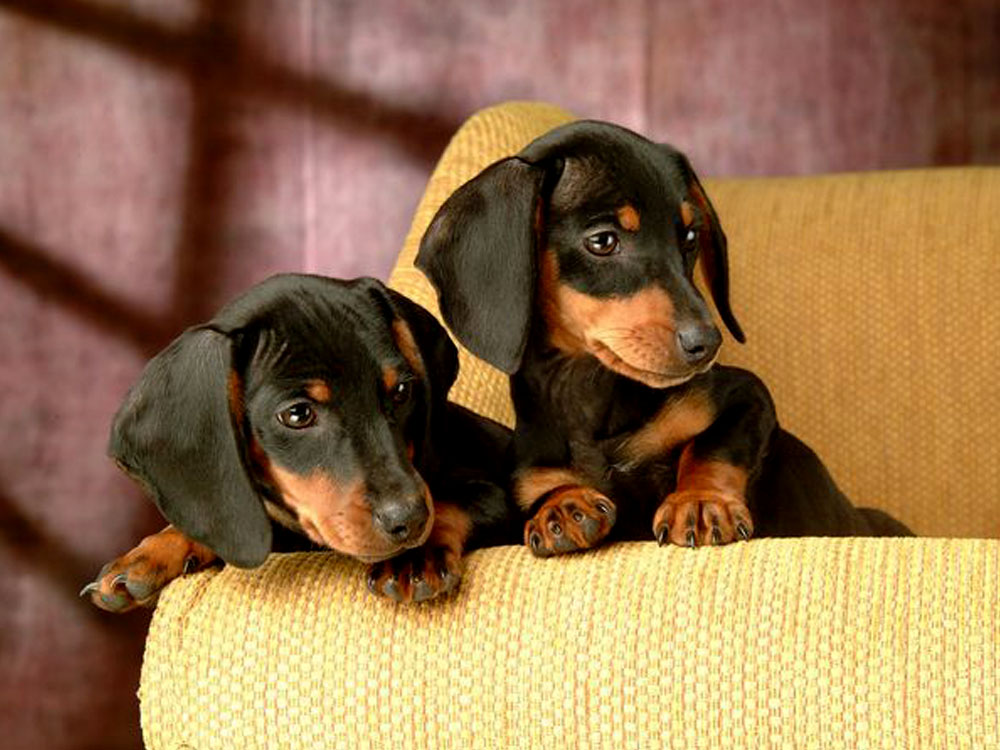
Miniature Dachshund Breed Pictures
Vital Breed Stats
| Height: | 13 - 18 cm M | 13 - 18 cm F |
| Weight: | 4 - 5 kg M | 4 - 5 kg F |
| Breed Group: | Toy Dog Group |
| Life Expectancy: | 11 - 14 years |
| KC Registered: | No |
Breed Characteristics
| Size: |  |
| Grooming: |  |
| Exercise Level: |  |
| Trainability: |  |
| Barking Level: |  |
| Good with Children: |  |
| Good with other pets: |  |
| Affectionate: |  |
| Protective: |  |
| Cost to Keep: |  |
Give a thumbs up if you love the Miniature Dachshund

0
More About the Breed
History
The history of the Dachshund breed can be traced back to the 16th century in Germany. Dachshund comes from the German words dachs (badger) and hund (dog) as it was a dog that hunted badgers. The breed came to the UK in 1840 when it was brought to England by the Royal Family.
During the 19th century, smaller Dachshunds were preferred as they were used to hunt European hares. Before they became popular pets, the smaller ones were, in fact, considered runts of the litters. Later on, as the demand rose for Mini Dachshunds, they were crossed with Toy Terriers and Pinschers. However, some of its desirable characteristics started to disappear specifically its above-average hunting skills. This type of breeding was eventually stopped in 1910 and breeders stuck with the more time-consuming selective breeding.
Appearance
How big will the Miniature Dachshunds get?
Miniature Dachshunds have an alert, bold and confident presence. They can easily be distinguished from the standard Dachshund because they are smaller and lower to ground. They weigh 4-5 kilograms and stand 13 to 18 centimetres at the withers.
They display an adorable appearance with short legs that highlight their long compact bodies. They have long heads, almond-shaped eyes, slightly arched muzzles, and broad and moderately long ears.
According to the breed standard, the miniature comes in smooth haired, longhaired, and wirehaired coat varieties.
Smooth-haired Dachshund
For the smooth Dachshund, the coat is short, shiny, and not too thick or too long. The underside has a patch of sleek hair that grows long. The tail is tapered and not richly haired. Hair colour varies widely but certain patterns and colours are more pronounced.
Red and cream predominate in single-coloured Dachshunds with acceptable white on the chest. Their nose and nails are black.
On the other hand, the recognised colours and combinations for two-coloured Dachshunds are black, chocolate, tan, cream, brindle, dapple, red, and silver. Depending on the hair colour, their nose and nails can be black, dark brown, or self-coloured.
Longhaired Dachshund
Longhaired Dachshunds have a long glistening coat with wavy hair growing longer under the neck, chest, the ears, behind the legs, and the underside of the body. Their tail hair can grow profusely. In terms of coat, nose, and nail colour, they share the same breed standard characteristics of their smooth-haired counterpart.
Wirehaired Dachshund
Wirehaired Dachshunds have short, thick, and rough outer coat except in the jaw, ears, and eyebrows. Their undercoat has finer and softer hair that are interspersed with coarser hairs. Their ears have shorter hair, while the tail has thick hairs. The most common colours for the wirehaired are wild boar (agouti), black, tan, and different shades of red.
Grooming
Smooth-haired Dachshund
Smooth-coated Dachshunds are generally low-maintenance because of their short and dense coat. Weekly brushing and wiping with a chamois leather will keep the coat clean and shiny.
Longhaired Dachshund
Because of the thickness of their coat, longhaired Dachshunds are the biggest shedders out of the three Dachshund varieties, but not as bad as other breeds. The longhaired Miniature Dachshunds are harder to maintain. They require frequent brushing with the use of a stiff-bristled brush and a comb to avoid tangles and matting.
The hair behind the ears, under the belly, and behind the legs need to be combed thoroughly. Taking them to the groomers is a good idea to thin out the area around the neck.
Wirehaired Dachshund
Grooming wirehaired Dachshunds involves plucking or hand-stripping the coat several times a year to keep the coat looking its best. Trimming the beard and eyebrows may be necessary when they get too long. Their coat needs to be brushed two to three times a week.
There are other aspects that need your attention and care, including dental health. Dachshunds are prone to gum and tooth disease because of their tiny jaws and crowded teeth. Start brushing its teeth when young so it gets used to the process. Also, make sure to trim the nails every month and clean the ears as necessary.
Temperament
In general, Dachshunds get along well with other dogs but they would not back down against a larger dog when threatened. It is better to avoid introducing smaller types of animals because of their strong prey drive.
Are Miniature Dachshunds aggressive?
Dachshunds typically bark and howl. This characteristic makes them good guard dogs for the family. They have a superb ability for alerting against intruders, however, their small stature will prevent them from defending their owners. The perceived aggressive behaviour is just their natural instincts kicking in to protect their turf when there is an apparent threat.
Read the miniature dachshund training tips and how to correct bad behaviours
Intelligence
The Miniature Dachshund is an active, intelligent, loyal and courageous hound. It may be a small dog, but what it lacks in size more than makes up in personality. It is recommended for families with older children who know how to responsibly handle dogs.
Although a quick learner, the Mini Dachshunds can be challenging to train as they have a stubborn streak. They may deliberately not follow commands from a timid owner. It is important to start training early to establish leadership.
Nutrition
- Senior and less active: up to 370 calories daily
- Typical adults: up to 460 calories daily
- Physically active/working dogs: up to 700 calories daily
Feeding
Health
Mini Dachshunds are generally healthy, however just like many other breeds, they are prone to their breed-specific health problems such as obesity, dental issues, thyroid problems, intervertebral disc disease (IVDD), patellar luxation, progressive retinal atrophy, Lafora disease, idiopathic epilepsy, and distichiasis.
They can also get skin problems like allergies, acanthosis nigricans, pattern alopecia, and vitiligo.
Learn more about Miniature Dachshund Health Problems and Prevention.
Exercise
Dachshunds are high-energy dogs with stamina that can really drain their owners. Make sure to provide your Mini Dachshund with physical and mental activities or it will find ways, often unpleasant, to amuse itself.
How much exercise does a Miniature Dachshund need?
As Miniature Dachshund is an active breed, a 30 to 40-minute daily exercise and playtime is enough. It enjoys walks and games in a fenced area. Avoid over-exercising your sausage dog when he is still young to avoid spine and joint problems.
Cost of Ownership
How much does a Miniature Dachshund cost?
A Miniature Dachshund puppy can cost anywhere from £900 to £1400. Expect to pay more if you purchase from a KC-registered breeder of Dachshund puppies (under The Kennel Club Assured Breeder program). On top of that, you have to pay for dog supplies such as collars, leashes, beds, crates, and toys for starters. Food expenses can set you back about £30 per month for high-quality dog food.
Grooming expenses depend on the type of coat; short-haired Miniature Dachshunds don’t need to be professionally groomed. Grooming services for long hair Dachshunds cost around £30 per visit.
Annual booster, vaccination and flea and worming treatments depend on the dog’s weight and it could cost up to £100. Basic pet insurance is around £240 annually.
Expect to shell out around £800 to £950 per year, the majority of which will go to food, veterinary expenses and pet insurance.
- Are you considering getting a Miniature Dachshund, read the 8 Questions To Ask Before Finding A Miniature Dachshund Puppy For Sale.
- Are you a new Miniature Dachshund owner, read the Do’s and Don’ts When Raising a Miniature Dachshund Puppy.
- Are you already owning a Dexie and wat to learn more about this wonderful breed, Read A Brief Guide of The Miniature Dachshund Breed.
Is a Miniature Dachshund Right for You?
- The Miniature Dachshund is a loyal breed that develops a strong bond with its owner.
- It is an intelligent breed but training can be challenging because it is stubborn.
- Interactions with small children should be supervised to avoid unintentional injuries.
- Always provide it with physical and mental activities to prevent it from amusing itself through negative me
- It may bark at intruders but won’t have the ability to defend you.
- Grooming is very easy for short-haired types and can be more demanding for the long-haired ones.
- This breed is prone to dental problems because of its small jaw and crowded teeth.
